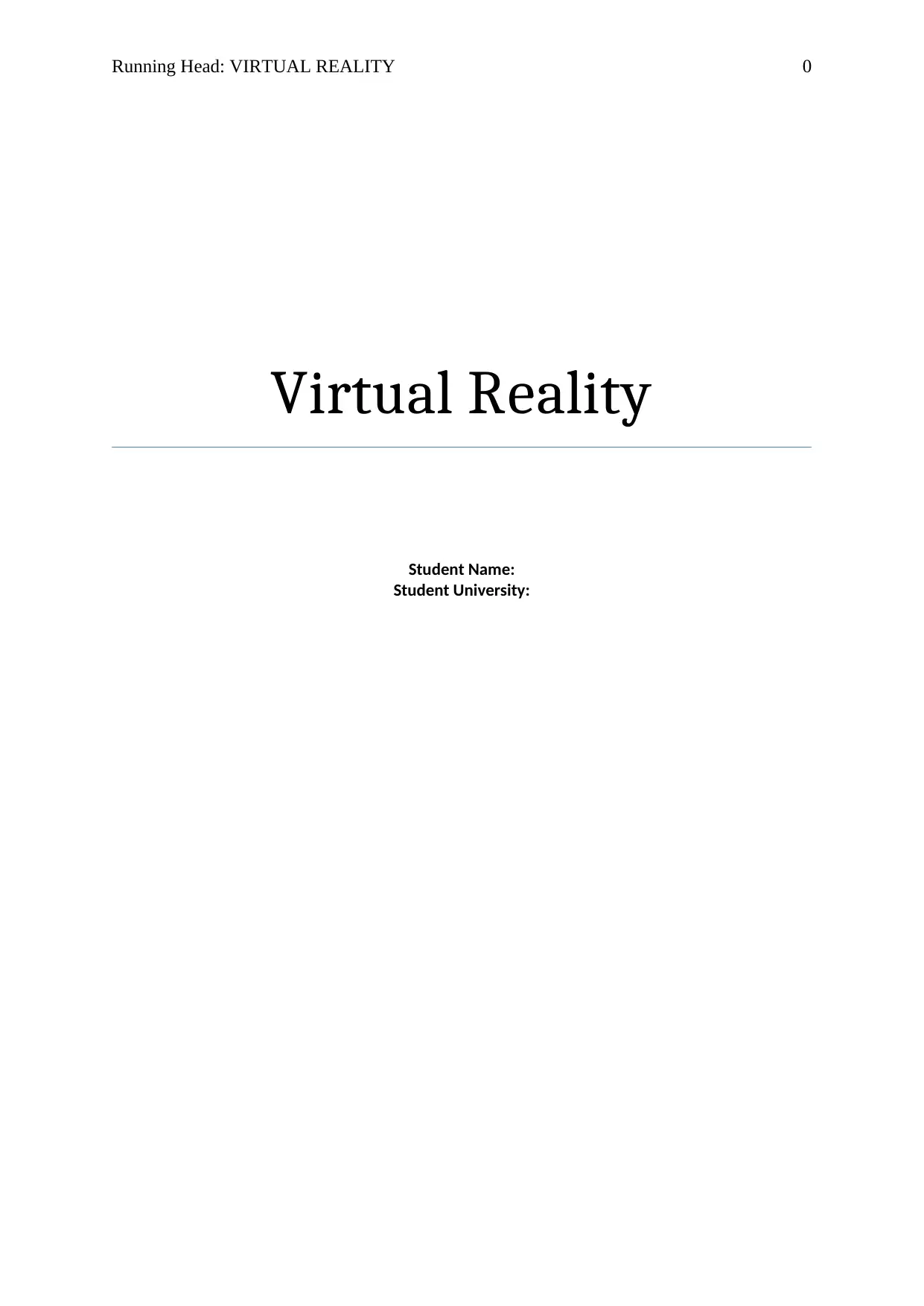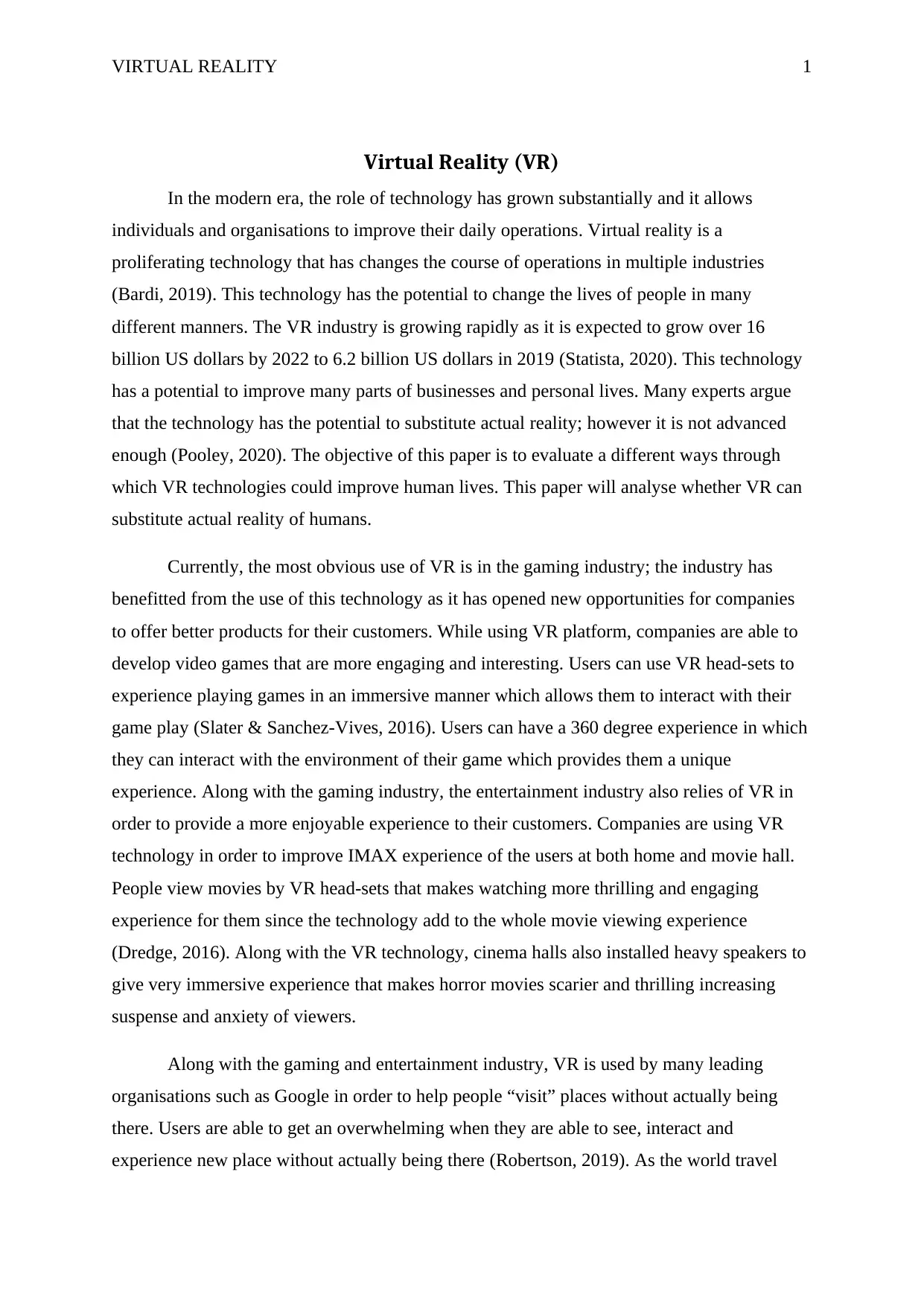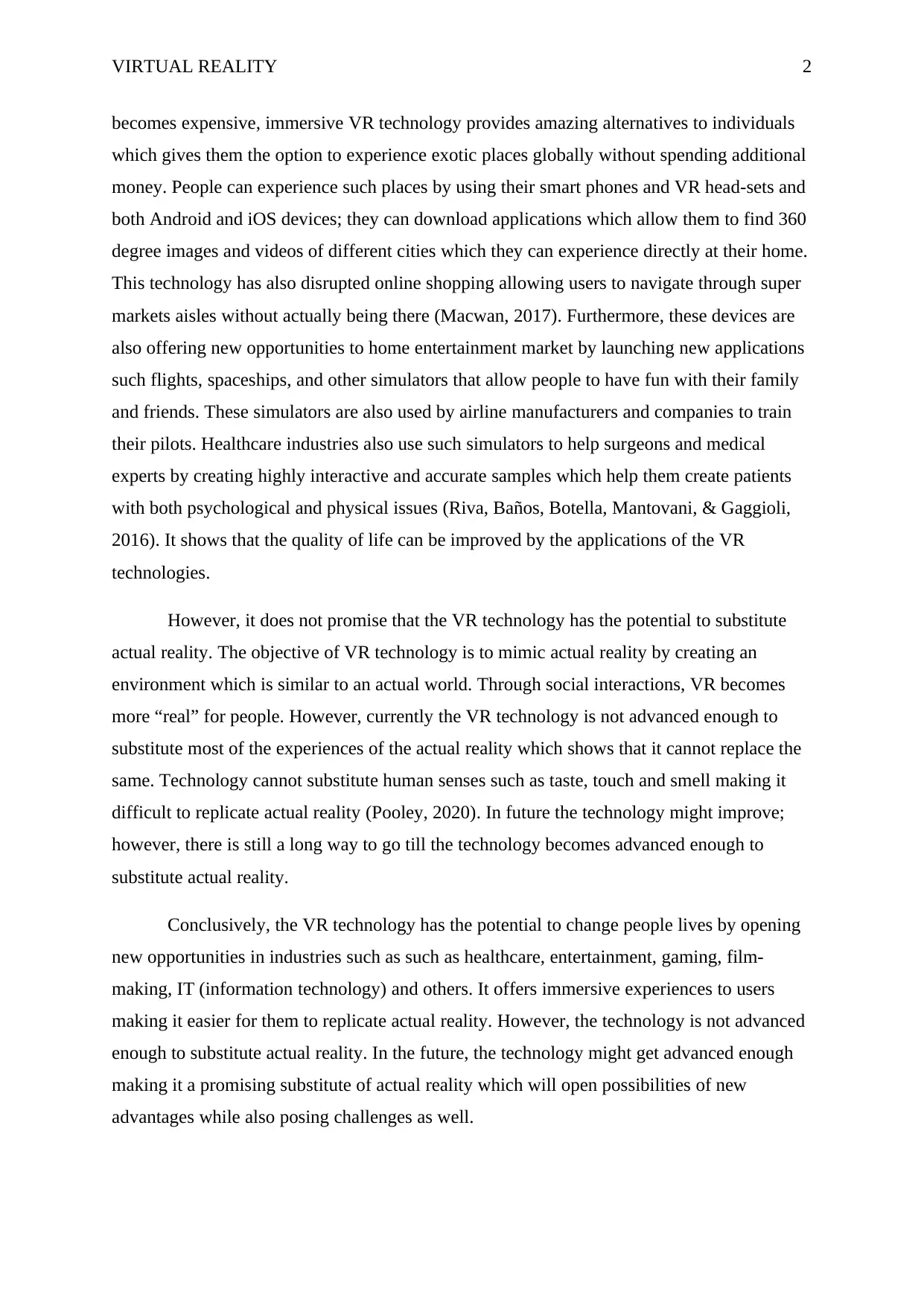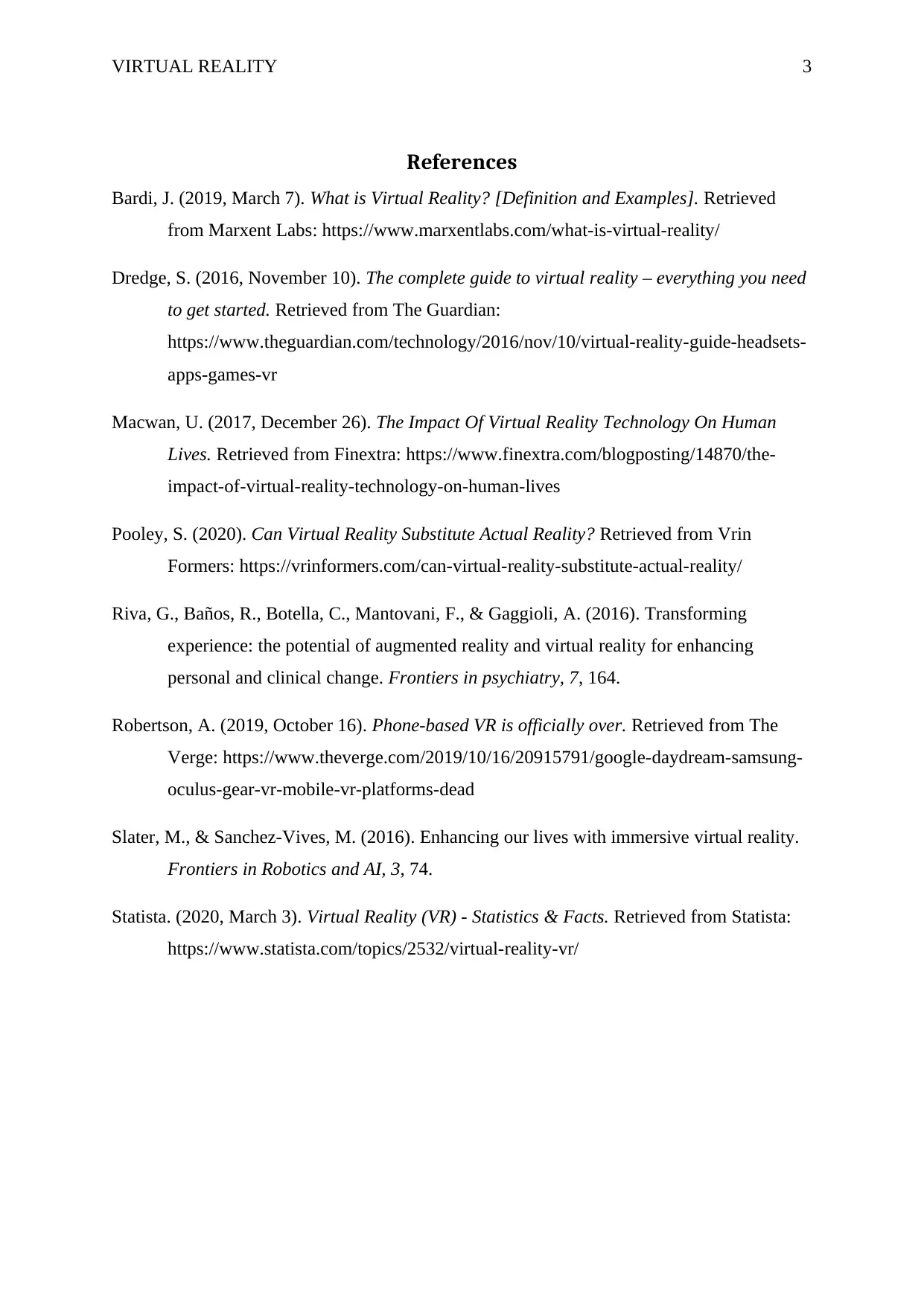Analyzing the Impact of Virtual Reality on Human Experiences
VerifiedAdded on 2022/08/26
|4
|1171
|13
Essay
AI Summary
This essay examines the multifaceted impact of virtual reality (VR) on human lives. It begins by highlighting the rapid growth of the VR industry and its potential to transform various sectors. The paper explores the applications of VR in the gaming and entertainment industries, emphasizing its ability to create immersive and engaging experiences. Furthermore, it discusses how VR is used by organizations like Google to facilitate virtual travel and shopping. The essay also touches on the use of VR in healthcare, particularly in training and simulation. While acknowledging the benefits of VR, the essay also evaluates whether VR can substitute actual reality, concluding that current technological limitations, such as the inability to replicate all human senses, prevent complete substitution. The essay concludes by emphasizing the potential for VR to continue to evolve and impact human experiences, posing both opportunities and challenges.

Running Head: VIRTUAL REALITY 0
Virtual Reality
Student Name:
Student University:
Virtual Reality
Student Name:
Student University:
Paraphrase This Document
Need a fresh take? Get an instant paraphrase of this document with our AI Paraphraser

VIRTUAL REALITY 1
Virtual Reality (VR)
In the modern era, the role of technology has grown substantially and it allows
individuals and organisations to improve their daily operations. Virtual reality is a
proliferating technology that has changes the course of operations in multiple industries
(Bardi, 2019). This technology has the potential to change the lives of people in many
different manners. The VR industry is growing rapidly as it is expected to grow over 16
billion US dollars by 2022 to 6.2 billion US dollars in 2019 (Statista, 2020). This technology
has a potential to improve many parts of businesses and personal lives. Many experts argue
that the technology has the potential to substitute actual reality; however it is not advanced
enough (Pooley, 2020). The objective of this paper is to evaluate a different ways through
which VR technologies could improve human lives. This paper will analyse whether VR can
substitute actual reality of humans.
Currently, the most obvious use of VR is in the gaming industry; the industry has
benefitted from the use of this technology as it has opened new opportunities for companies
to offer better products for their customers. While using VR platform, companies are able to
develop video games that are more engaging and interesting. Users can use VR head-sets to
experience playing games in an immersive manner which allows them to interact with their
game play (Slater & Sanchez-Vives, 2016). Users can have a 360 degree experience in which
they can interact with the environment of their game which provides them a unique
experience. Along with the gaming industry, the entertainment industry also relies of VR in
order to provide a more enjoyable experience to their customers. Companies are using VR
technology in order to improve IMAX experience of the users at both home and movie hall.
People view movies by VR head-sets that makes watching more thrilling and engaging
experience for them since the technology add to the whole movie viewing experience
(Dredge, 2016). Along with the VR technology, cinema halls also installed heavy speakers to
give very immersive experience that makes horror movies scarier and thrilling increasing
suspense and anxiety of viewers.
Along with the gaming and entertainment industry, VR is used by many leading
organisations such as Google in order to help people “visit” places without actually being
there. Users are able to get an overwhelming when they are able to see, interact and
experience new place without actually being there (Robertson, 2019). As the world travel
Virtual Reality (VR)
In the modern era, the role of technology has grown substantially and it allows
individuals and organisations to improve their daily operations. Virtual reality is a
proliferating technology that has changes the course of operations in multiple industries
(Bardi, 2019). This technology has the potential to change the lives of people in many
different manners. The VR industry is growing rapidly as it is expected to grow over 16
billion US dollars by 2022 to 6.2 billion US dollars in 2019 (Statista, 2020). This technology
has a potential to improve many parts of businesses and personal lives. Many experts argue
that the technology has the potential to substitute actual reality; however it is not advanced
enough (Pooley, 2020). The objective of this paper is to evaluate a different ways through
which VR technologies could improve human lives. This paper will analyse whether VR can
substitute actual reality of humans.
Currently, the most obvious use of VR is in the gaming industry; the industry has
benefitted from the use of this technology as it has opened new opportunities for companies
to offer better products for their customers. While using VR platform, companies are able to
develop video games that are more engaging and interesting. Users can use VR head-sets to
experience playing games in an immersive manner which allows them to interact with their
game play (Slater & Sanchez-Vives, 2016). Users can have a 360 degree experience in which
they can interact with the environment of their game which provides them a unique
experience. Along with the gaming industry, the entertainment industry also relies of VR in
order to provide a more enjoyable experience to their customers. Companies are using VR
technology in order to improve IMAX experience of the users at both home and movie hall.
People view movies by VR head-sets that makes watching more thrilling and engaging
experience for them since the technology add to the whole movie viewing experience
(Dredge, 2016). Along with the VR technology, cinema halls also installed heavy speakers to
give very immersive experience that makes horror movies scarier and thrilling increasing
suspense and anxiety of viewers.
Along with the gaming and entertainment industry, VR is used by many leading
organisations such as Google in order to help people “visit” places without actually being
there. Users are able to get an overwhelming when they are able to see, interact and
experience new place without actually being there (Robertson, 2019). As the world travel

VIRTUAL REALITY 2
becomes expensive, immersive VR technology provides amazing alternatives to individuals
which gives them the option to experience exotic places globally without spending additional
money. People can experience such places by using their smart phones and VR head-sets and
both Android and iOS devices; they can download applications which allow them to find 360
degree images and videos of different cities which they can experience directly at their home.
This technology has also disrupted online shopping allowing users to navigate through super
markets aisles without actually being there (Macwan, 2017). Furthermore, these devices are
also offering new opportunities to home entertainment market by launching new applications
such flights, spaceships, and other simulators that allow people to have fun with their family
and friends. These simulators are also used by airline manufacturers and companies to train
their pilots. Healthcare industries also use such simulators to help surgeons and medical
experts by creating highly interactive and accurate samples which help them create patients
with both psychological and physical issues (Riva, Baños, Botella, Mantovani, & Gaggioli,
2016). It shows that the quality of life can be improved by the applications of the VR
technologies.
However, it does not promise that the VR technology has the potential to substitute
actual reality. The objective of VR technology is to mimic actual reality by creating an
environment which is similar to an actual world. Through social interactions, VR becomes
more “real” for people. However, currently the VR technology is not advanced enough to
substitute most of the experiences of the actual reality which shows that it cannot replace the
same. Technology cannot substitute human senses such as taste, touch and smell making it
difficult to replicate actual reality (Pooley, 2020). In future the technology might improve;
however, there is still a long way to go till the technology becomes advanced enough to
substitute actual reality.
Conclusively, the VR technology has the potential to change people lives by opening
new opportunities in industries such as such as healthcare, entertainment, gaming, film-
making, IT (information technology) and others. It offers immersive experiences to users
making it easier for them to replicate actual reality. However, the technology is not advanced
enough to substitute actual reality. In the future, the technology might get advanced enough
making it a promising substitute of actual reality which will open possibilities of new
advantages while also posing challenges as well.
becomes expensive, immersive VR technology provides amazing alternatives to individuals
which gives them the option to experience exotic places globally without spending additional
money. People can experience such places by using their smart phones and VR head-sets and
both Android and iOS devices; they can download applications which allow them to find 360
degree images and videos of different cities which they can experience directly at their home.
This technology has also disrupted online shopping allowing users to navigate through super
markets aisles without actually being there (Macwan, 2017). Furthermore, these devices are
also offering new opportunities to home entertainment market by launching new applications
such flights, spaceships, and other simulators that allow people to have fun with their family
and friends. These simulators are also used by airline manufacturers and companies to train
their pilots. Healthcare industries also use such simulators to help surgeons and medical
experts by creating highly interactive and accurate samples which help them create patients
with both psychological and physical issues (Riva, Baños, Botella, Mantovani, & Gaggioli,
2016). It shows that the quality of life can be improved by the applications of the VR
technologies.
However, it does not promise that the VR technology has the potential to substitute
actual reality. The objective of VR technology is to mimic actual reality by creating an
environment which is similar to an actual world. Through social interactions, VR becomes
more “real” for people. However, currently the VR technology is not advanced enough to
substitute most of the experiences of the actual reality which shows that it cannot replace the
same. Technology cannot substitute human senses such as taste, touch and smell making it
difficult to replicate actual reality (Pooley, 2020). In future the technology might improve;
however, there is still a long way to go till the technology becomes advanced enough to
substitute actual reality.
Conclusively, the VR technology has the potential to change people lives by opening
new opportunities in industries such as such as healthcare, entertainment, gaming, film-
making, IT (information technology) and others. It offers immersive experiences to users
making it easier for them to replicate actual reality. However, the technology is not advanced
enough to substitute actual reality. In the future, the technology might get advanced enough
making it a promising substitute of actual reality which will open possibilities of new
advantages while also posing challenges as well.
⊘ This is a preview!⊘
Do you want full access?
Subscribe today to unlock all pages.

Trusted by 1+ million students worldwide

VIRTUAL REALITY 3
References
Bardi, J. (2019, March 7). What is Virtual Reality? [Definition and Examples]. Retrieved
from Marxent Labs: https://www.marxentlabs.com/what-is-virtual-reality/
Dredge, S. (2016, November 10). The complete guide to virtual reality – everything you need
to get started. Retrieved from The Guardian:
https://www.theguardian.com/technology/2016/nov/10/virtual-reality-guide-headsets-
apps-games-vr
Macwan, U. (2017, December 26). The Impact Of Virtual Reality Technology On Human
Lives. Retrieved from Finextra: https://www.finextra.com/blogposting/14870/the-
impact-of-virtual-reality-technology-on-human-lives
Pooley, S. (2020). Can Virtual Reality Substitute Actual Reality? Retrieved from Vrin
Formers: https://vrinformers.com/can-virtual-reality-substitute-actual-reality/
Riva, G., Baños, R., Botella, C., Mantovani, F., & Gaggioli, A. (2016). Transforming
experience: the potential of augmented reality and virtual reality for enhancing
personal and clinical change. Frontiers in psychiatry, 7, 164.
Robertson, A. (2019, October 16). Phone-based VR is officially over. Retrieved from The
Verge: https://www.theverge.com/2019/10/16/20915791/google-daydream-samsung-
oculus-gear-vr-mobile-vr-platforms-dead
Slater, M., & Sanchez-Vives, M. (2016). Enhancing our lives with immersive virtual reality.
Frontiers in Robotics and AI, 3, 74.
Statista. (2020, March 3). Virtual Reality (VR) - Statistics & Facts. Retrieved from Statista:
https://www.statista.com/topics/2532/virtual-reality-vr/
References
Bardi, J. (2019, March 7). What is Virtual Reality? [Definition and Examples]. Retrieved
from Marxent Labs: https://www.marxentlabs.com/what-is-virtual-reality/
Dredge, S. (2016, November 10). The complete guide to virtual reality – everything you need
to get started. Retrieved from The Guardian:
https://www.theguardian.com/technology/2016/nov/10/virtual-reality-guide-headsets-
apps-games-vr
Macwan, U. (2017, December 26). The Impact Of Virtual Reality Technology On Human
Lives. Retrieved from Finextra: https://www.finextra.com/blogposting/14870/the-
impact-of-virtual-reality-technology-on-human-lives
Pooley, S. (2020). Can Virtual Reality Substitute Actual Reality? Retrieved from Vrin
Formers: https://vrinformers.com/can-virtual-reality-substitute-actual-reality/
Riva, G., Baños, R., Botella, C., Mantovani, F., & Gaggioli, A. (2016). Transforming
experience: the potential of augmented reality and virtual reality for enhancing
personal and clinical change. Frontiers in psychiatry, 7, 164.
Robertson, A. (2019, October 16). Phone-based VR is officially over. Retrieved from The
Verge: https://www.theverge.com/2019/10/16/20915791/google-daydream-samsung-
oculus-gear-vr-mobile-vr-platforms-dead
Slater, M., & Sanchez-Vives, M. (2016). Enhancing our lives with immersive virtual reality.
Frontiers in Robotics and AI, 3, 74.
Statista. (2020, March 3). Virtual Reality (VR) - Statistics & Facts. Retrieved from Statista:
https://www.statista.com/topics/2532/virtual-reality-vr/
1 out of 4
Related Documents
Your All-in-One AI-Powered Toolkit for Academic Success.
+13062052269
info@desklib.com
Available 24*7 on WhatsApp / Email
![[object Object]](/_next/static/media/star-bottom.7253800d.svg)
Unlock your academic potential
Copyright © 2020–2025 A2Z Services. All Rights Reserved. Developed and managed by ZUCOL.





